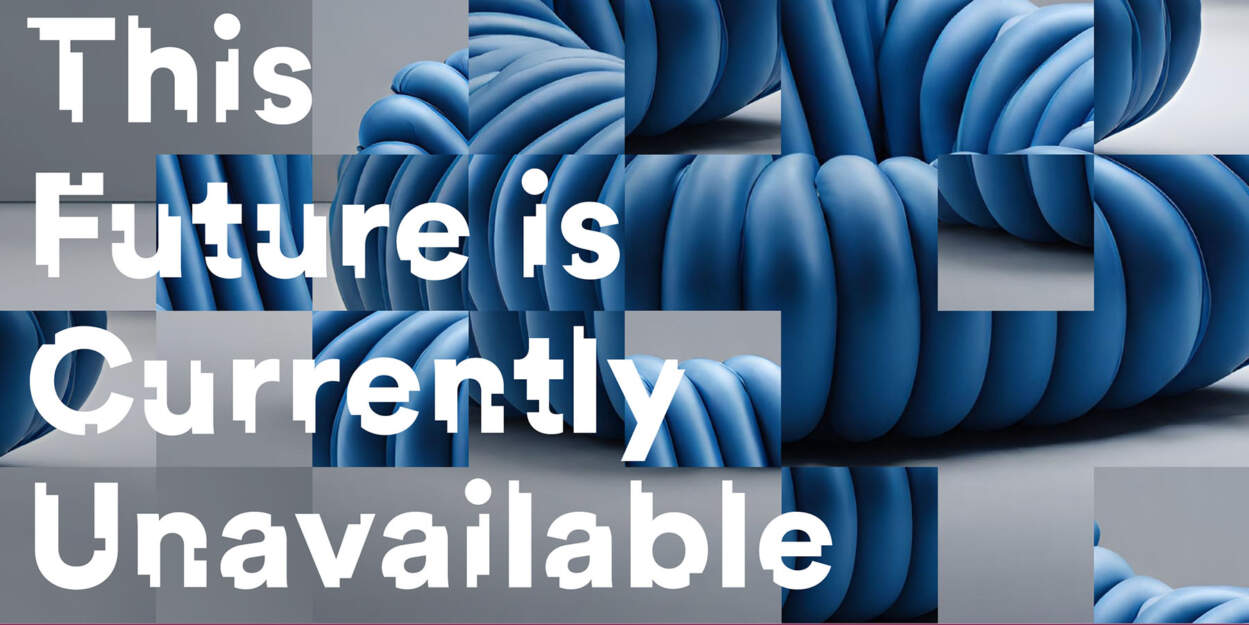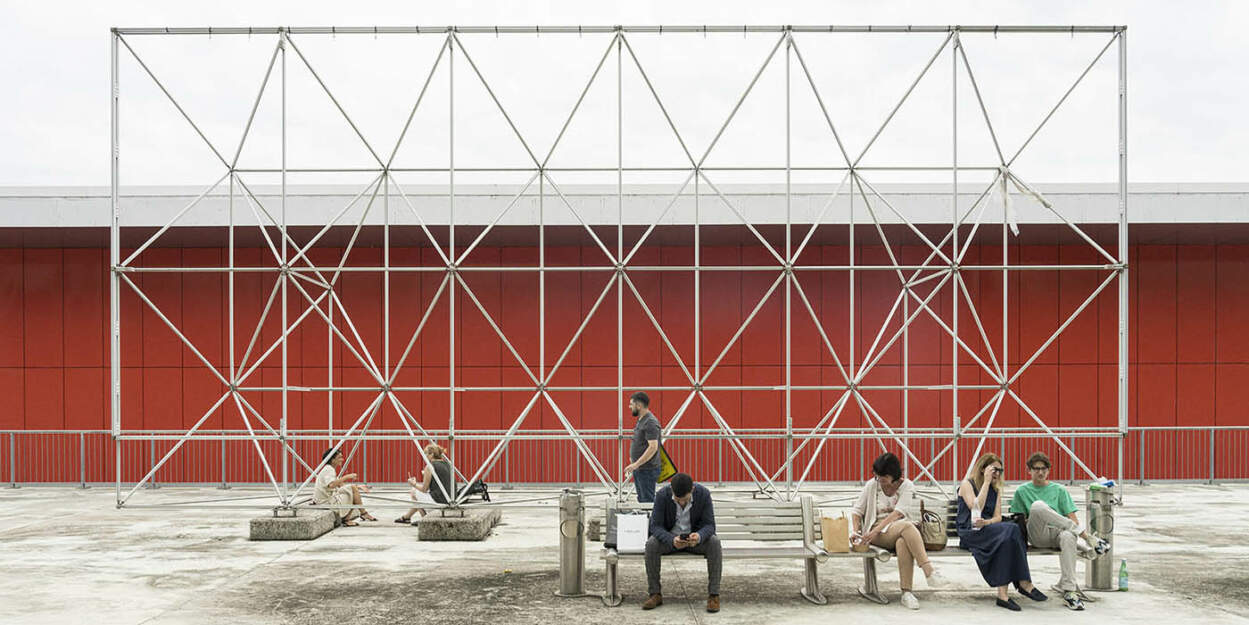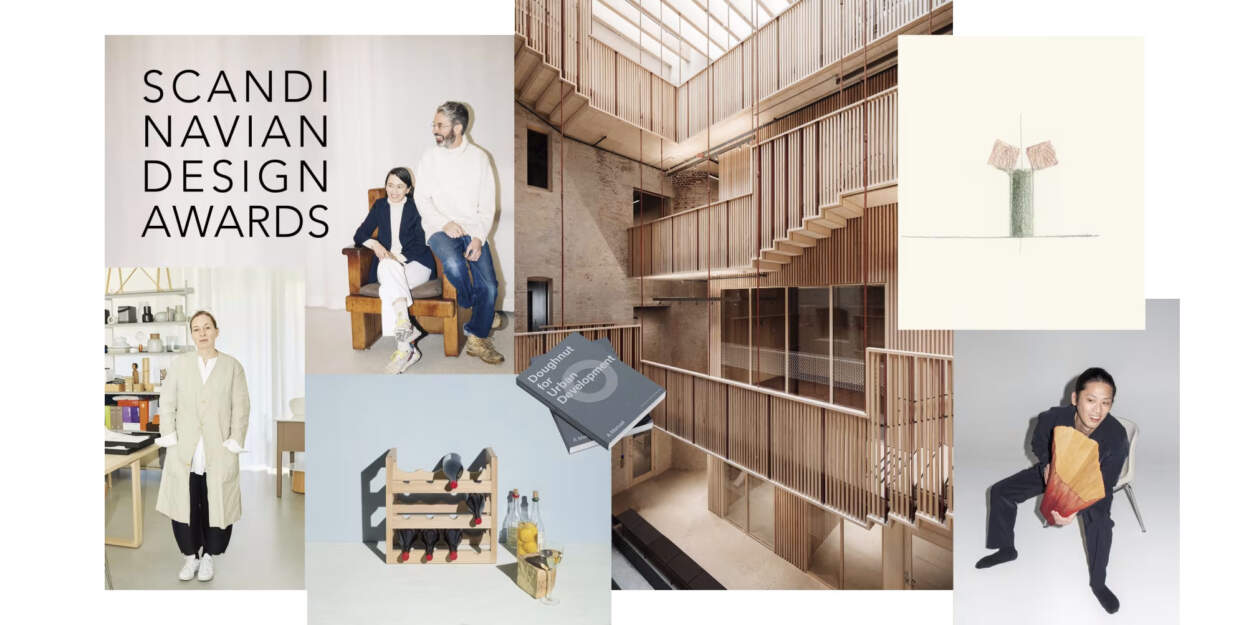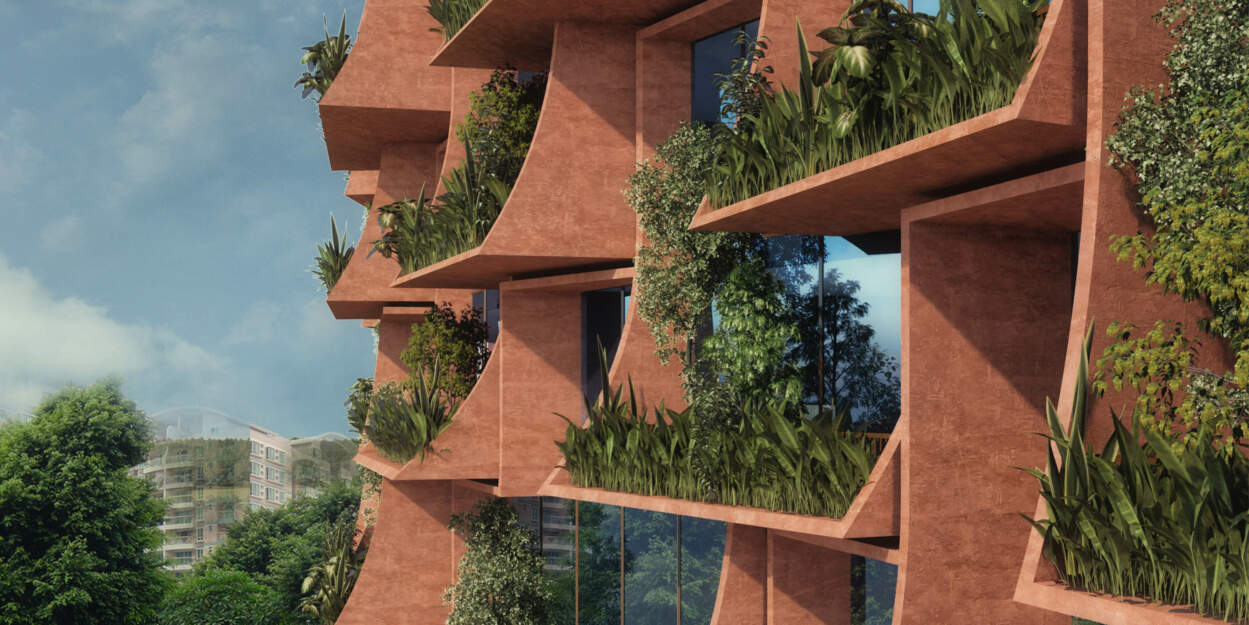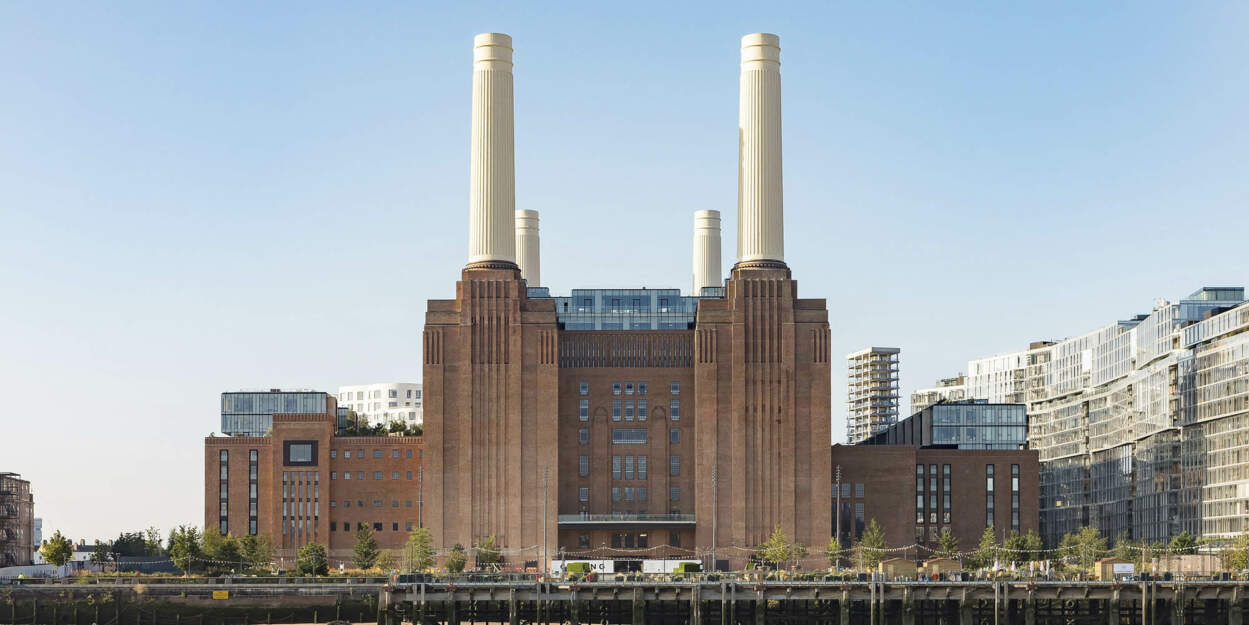Circular economy in the built environment has not been a focal point of architects in the past as factors such as timing, schedule and budget requirements.
As we know, the circular economy model aims to redefine growth, focusing on positive society-wide benefits. It even developed the sustainable design model based on less material usage, recyclability and technical and aesthetic durability principles.
The circular economy model has its roots in concepts dating back to the 1970s, including the Club of Rome's ‘Limits to Growth' theory, Braungart and McDonough's ‘cradle to cradle' concept, Stahel's ‘performance economy', and Lyle's ‘regenerative design' model, to name a few.
The economic model that drove architecture until today is linear. Aligned with the take-make-waste extractive industrial model, the built environment sector is a major consumer of natural resources.
It is responsible for over 35% of the EU's total waste generation [EU – A new Circular Economy Action Plan]. The leading cause of waste, and a large culprit for emissions, is the construction and demolition industry. It is also the world's largest consumer of raw materials, with about 3 billion tons annually. [Arup, 2016] and it is responsible for up to 40% of our CO2-emissions.
More than at any time before, we need to apply circular economy and resource efficiency principles to reduce resource use in the future.
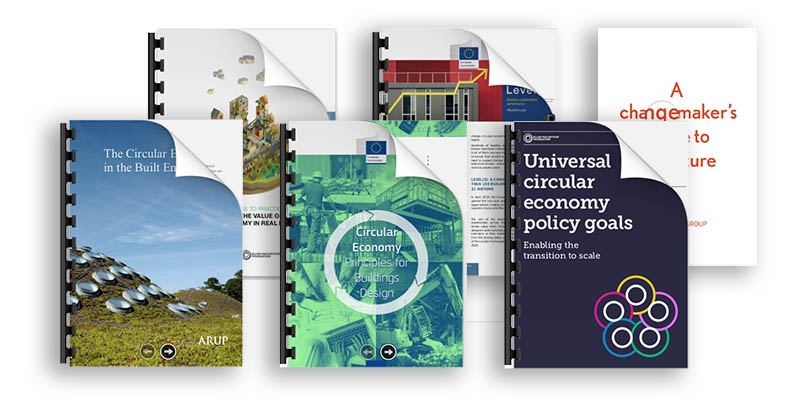
What are circular economy in the built environment principles?
Circular economy entails gradually decoupling economic activity from the consumption of finite resources and designing waste second life.
On April 2018, the European Commission officially opened the two-year testing phase for Level(s) to organisations looking to be part of Europe's shift towards circular and lifecycle thinking. Level(s) is the European approach to assess and report on the sustainability performance of buildings, throughout the full life cycle of buildings.
On February 2020, the European Commission released a more focused paper on circular economy in architecture: the “Circular Economy – Principles for Building Design” document.
They have summarised an adapted these scenario headings as follows:
- Durability: building and elemental service life planning, encouraging a medium to long term focus on the design life of major building elements, as well as their associated maintenance and replacement cycles;
- Adaptability: to extend the service life of the building as a whole, either by facilitating the continuation of the intended use or through possible future changes in use – with a focus on replacement and refurbishment;
- Reduce waste and facilitate high-quality waste management: facilitate the future circular use of building elements, components and parts, with a focus on producing less waste and on the potential for the reuse, or high-quality recycling of major building elements following deconstruction. This includes efforts along the value chain to promote:
-
- the reuse or recycling of resources, (i.e. materials) in a way that most of the material's value is retained and recovered at the end of a building's life span;
- the component design and the use of different construction methods to influence the recovery for reuse or recycling to avoid down-cycling.
The actors involved in the document are building users, facility managers and owners, design teams (engineering & architecture of buildings), contractors and builders, manufacturers of construction products, deconstruction and demolition teams, investors, developers and insurance providers, government, regulators and local authorities.
The European Commission has adopted a new Circular Economy Action Plan – one of the main blocks of the European Green Deal, Europe's new agenda for sustainable growth. To exploit the potential for increasing material efficiency and reducing climate impacts, the European Commission will launch a new comprehensive Strategy for a Sustainable Built Environment.
This Strategy should ensure coherence across the relevant policy areas such as climate, energy and resource efficiency, management of construction and demolition waste, accessibility, digitalisation and skills.
Developed by McKinsey, the ReSOLVE framework, is the key output of the Ellen MacArthur Foundation's research, a charity dedicated to promoting the global transition to the circular economy.
This framework translated the principles of the circular economy into six business actions to guide the transition towards a circular economy that can be applied to products, buildings, neighbourhoods, cities, regions, or even to entire economies:
1. Regenerate: regenerating and restoring natural capital
2. Share: maximising asset utilisation
3. Optimise: optimising system performance
4. Loop: keeping products and materials in cycles, prioritising inner loops
5. Virtualise: displacing resource use with virtual use
6. Exchange: Selecting resources and technology wisely
On January 2021, the Ellen MacArthur Foundation published a set of “Universal circular economy policy goals” to create a common direction of travel in policy development for a faster transition to a circular economy.
This policy goals document has been released to avoid the creation of a patchwork of fragmented solutions and to offer solutions to key global challenges such as climate change, biodiversity loss, and pollution, whilst delivering economic development.
Circular economy in architecture best practices
Among the most inspiring best practices, Realdania Byg, a Danish foundation that promotes innovation and good practice in the building sector, developed and constructed a single-family house with Lendager Group called Upcycle House conveying the principles of upcycling in a tangible and clear example.
It is an experimental project, aimed at exposing potential carbon-emission reductions through the use of recycled and upcycled building materials.
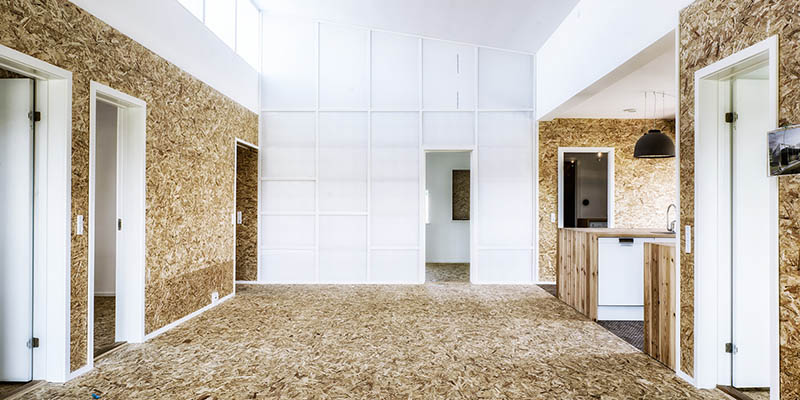
Upcycle House by Lendager Group | Photography: Jesper Ray
Among the better known, but not yet widely adopted, circular design strategy is the shearing layers model provided by ARUP and Ellen MacArthur Foundation.
Building in layers means elements with different lifespans can be separated and removed, allowing longer-lasting elements to be kept in use even if those with shorter lifespans require replacing.
This facilitates reuse, remanufacture and recycling. Building in separate layers with different lifespans also allows each element to be repaired, replaced, moved or adapted at different times without affecting the whole building or infrastructure asset.
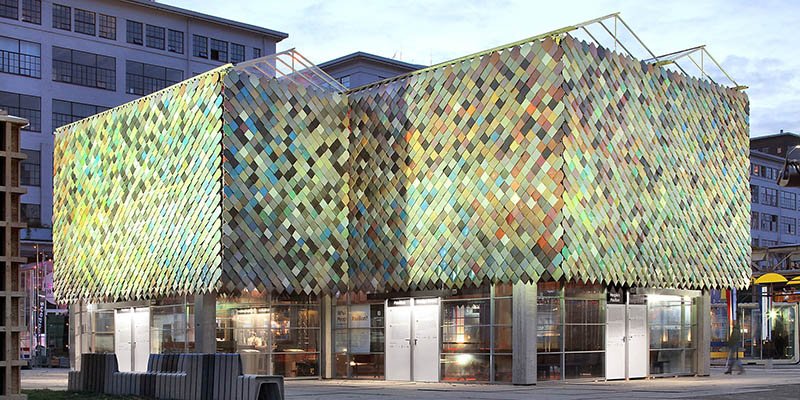
People ‘s Pavilion | Photography: Filip Dujardin
Another pioneeristic circular economy building was designed by ARUP in 2017. The People ‘s Pavilion is temporary building completely built from borrowed material. They devised a construction technique that didn't use glue, screws or nails.
The frame was build up from standard off-the-shelve timber sections of different trade lengths tied together with steel straps to make longer and stronger composite elements. The columns consist of 7 meter tall prefab concrete foundation piles. Steel rods from a demolished office building are reused as cross bracing. After the event, the building has been successfully dismantled and all the materials returned to the suppliers.
Architects and engineers, as decision makers, are facing several existing or potential dilemmas: structural resistance versus easy to disassemble, longevity versus flexibility, simple versus composite products, renovations versus new-build, rock wool versus wood wool etc.
They should be familiar with design requirements and strategies, the concept of life cycle assessment (LCA), the potential to increase the content of recycled materials in products, future reuse potential (product, component and building); future recyclability and transformation capacity, reuse potential and reversible building design score…
As stated in the “Life Cycle Assessment of building end of life” released by the Politecnico di Milano ABC Department, the end-of-life LCA is highly uncertain in building sector, because generally many data are supposed, also because the end of life of building occurs in the future.
To calculate benefits and loads there is the need to take into account several assumptions about, for example, types of treatment, distance to plants of treatment, the quantity of materials analysed, the efficiency of material recycling and the efficiency of technology and practices (existing or future).
Many discussion are still open, such as about the type of modelling between consequential and attributional, the end-of-life phases to be considered, and the poor of data quality.
How circular economy in the building sector contributes to sustainability?
“From our point of view circular economy is just one of many aspects of sustainability, which is a really complex topic. For this reason, a number of certification systems have been established that check relevant criteria, including resource efficiency principles and social impacts.” say from J. Mayer H. und Partner Architekten. “We have illustrated this complexity in our exhibition design “Level Green” for the Autostadt in Wolfsburg (2009). Metropol Parasol (2011) and the earlier Project Mensa Karlsruhe (2007) were opportunities for us to build with certified timber material on a larger scale.
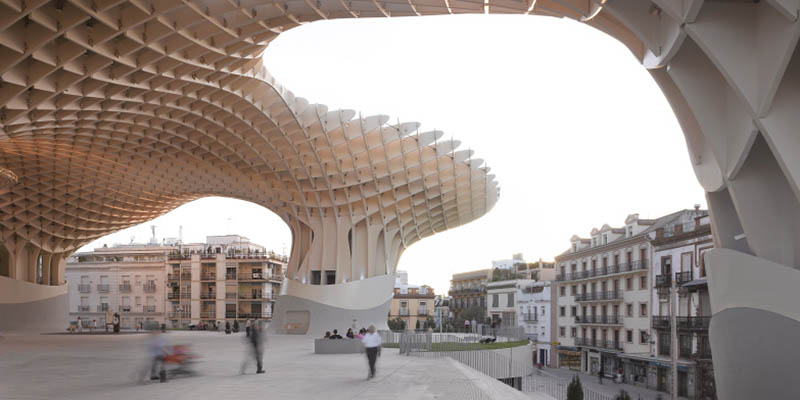
Metropol Parasol by J. Mayer H. und Partner Architekten, Seville, Spain | Photography: David Franck
Although we always have sustainable aspects in mind, we naturally do not always find such opportunities in our practice. In fact, working on sustainability is still a progress in small steps depending on the attitude of our clients, industrial building standards and building legislation that give us opportunities and possibilities to develop sustainable solutions. With every project we aim to explore the potential of the sustainable parameters and we are happy to receive more requests for timber buildings from our clients at the moment.”
How to implement circular economy in the built environment?
The client ‘s side.
Yet until now, consideration of circular economy principles in architecture has principally focussed on design strategies, which is only half the story. How do real estate business models also need to change if circular economy principles in architecture are to scale in this sector? The ARUP report called “From principles to practices: realising the value of circular economy in real estate” tells the other half.
GXN, the innovation arm of renowned Danish architecture firm 3XN, have collaborated with ARUP and the Ellen MacArthur Foundation as contributors on this report presenting five circular investment models targeted at investors, developers and building owners.
The 5 models presented each in their own way show how the circular economy can provide new income streams in the building sector: Flexible Adaptable, Spaces Assets, Relocatable Residual, Buildings Value and Performance Procurement. As they affirm, what is needed now are commercial-scale pilot projects to demonstrate this potential is achievable.
“With the circular economy, GXN and 3XN want to challenge and rethink the way we use and reuse resources in the building industry, with the ultimate goal being to eliminate the concept of waste. There is no waste in nature, everything acts as input or nutrient for something else” says Kåre Stokholm Poulsgaard Head of Innovation at 3XN/GXN.
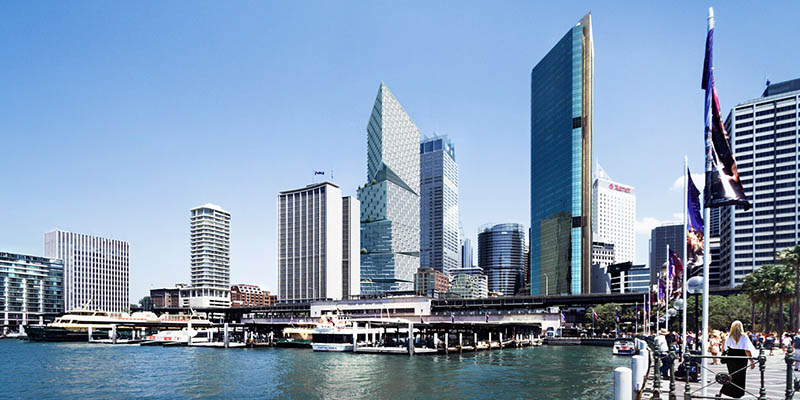
Quay Quarter Tower by 3XN, Sydney, Australia | Courtesy: 3XN/GXN
“The example of the 3XN designed Quay Quarter Tower in Sydney shows how circular thinking provides immediate value for construction clients and building tenants. The redesign of the 49 story, 200 meter tall high-rise reuses substantial parts of the existing structure, while transforming the tower into a state-of-the-art office building with flexible facilities and optimised views of the harbour. 50% of the resources required for the new tower were directly reused from the existing building, with estimated savings to the client of 130.000.000 AUD, and a total of 7.505 tons of CO2 saved by reusing materials”
Despite models and studies, circular economy approaches will only be adopted at scale in architecture if business models change. In other words, circular economy needs to be viewed as a business strategy, not just a waste management or a design strategy.
“We see lots of innovation pouring into the technical challenges: how to design for disassembly, how to keep things modular, how to produce and store green energy, how to insulate homes, whether to use hydrogen or not. But we don't see enough focus on the social implications of this shift” says Sascha Glasl, founder of Space&Matter.
“It is our strong belief that there will be no circular economy without people playing an active part. The technological shift is (relatively) straightforward; the cultural shift is more complex. How to radically decarbonise our lives in a way which is socially inclusive and (financially) feasible for all, a way which leaves no one behind? Giving form to social and ecological urbanism is the challenge faced by architects today. For this we need to broaden our urban imagination.
We need to think beyond buildings and into business models. There's no point designing for disassembly if there's no financial incentive for the owner to disassemble those components at the end of the building's lifespan and reuse them. Architects have a big role to play in this, but we need to broaden our scope. Here at Space&Matter we don't just settle for designing nice things.
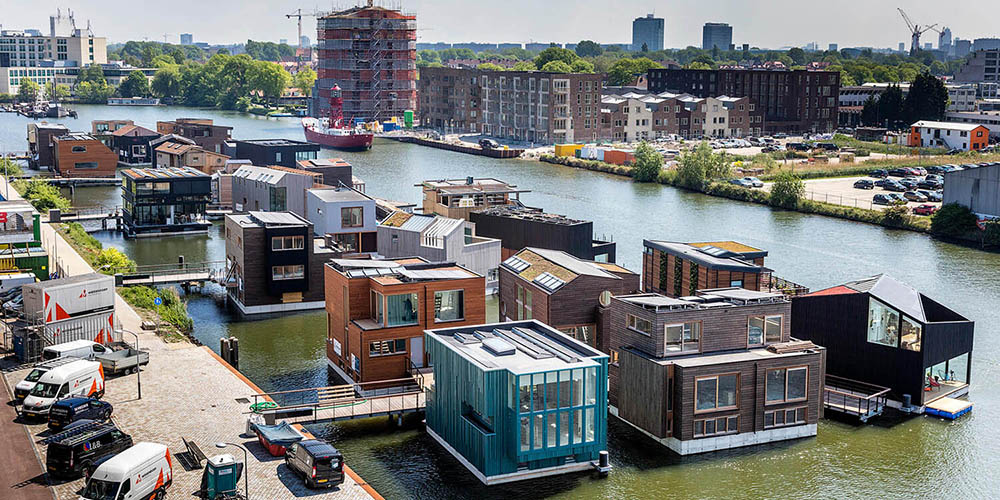
Schoonschip floating houses by Space&Matters | Photography: Space&Matter
We design place-based systems, relationships, business ventures and strategies which move the planet towards a fundamentally more sustainable state such as De Ceuvel and Schoonschip. We work directly with communities to ensure their needs are an essential part of the project brief.
De Ceuvel was envisioned, designed and developed with the community who now rents the workspaces. And Schoonschip was even initiated and developed fully bottom-up, by future residents themselves. By commissioning us for a smart urban plan and plot passports, we were able to support them with the structure they needed to realise their dream. Both processes ensure a network of stewardship and care which will keep the neighbourhoods operating in a circular way for perpetuity”.
How to measure circular economy in the building sector?
The supplier ‘s side.
“Innovation in product design and access to more data will drive better developments. Getting more out of what we already have will be important. Better connecting what we do, particularly when we think of our supply chain systems, existing built assets, and waste/resource flows across our developments, will help us deliver more for less.” says Dr Kristian Steele, member of the Advanced Technology and Research group at ARUP.
“The most important thing is to understand what is LCA and what are the barriers. It is easy to say that we don't have enough data to use life cycle analysis in the right way. Which is true, but partly” says Anders Lendager founder of Lendager Group. “In all our projects we created all the data ourselves because we could. I know how many Kilometers materials drove from waste to resource, from resource to production, the production energy, what it costs, how much time it takes until these material hit the building ground… all these data is collected and I have LCA for that, specifically for upscaled windows, upscaled concrete.”
“All these data are available but the real problem is that we don't have database to collect and share all these data globally or better locally to evaluate the impact.”
“I've been working with the Danish Housing Minister” continues Anders “and I suggested him that we need, as Danish, to collect local data instead of global data that work for everyone. Not German data or Swedish data, but Danish data. When you have these data you can set the bar for a full LCA and circular economy of the materials. This is the only way to be aware about the sustainability of materials. If manufacturing companies don't provide data because they say that is too complex means that there are problems behind…”
Technological advances are accelerating the development of the circular economy. Sharing platforms such as FLOOW2, Globechain and HeadBox are helping to address the issues of under-used assets and superfluous capacity – facilitating trust and collaboration on the reuse of materials and assets. [The Circular Economy in the Built Environment, ARUP]
The European Commission concluded that Life Cycle Assessments provide the best framework for assessing the potential environmental impacts of products currently available. They also state the need for more consistent data and consensus.
The Commission provided a platform called EPLCA to facilitate communication and exchanges on life-cycle data and launch a co-ordination initiative involving both ongoing data collection efforts in the EU and existing harmonisation initiatives.
Supply chain, building materials and furnishings manufacturer, now have to respond to their leads, investing in new solutions providing:
- use of renewable materials
- use of healthy materials
- production processes with low environmental impact
- materials have a high recycled content
- durable materials
- non-hazardous materials
- products that can be reused, disassembled, and recycled
- create material passports
Referring to building materials, we already described benefits of using timber in architecture in our serie “Benefits of timber architecture and sustainably sourced timber“.
Increasing numbers of architects, developers, governments, educational institutions and corporations are embracing wood. Timber, in its range of many different products such as cross laminated timber (CLT), glue laminated timber (Glulam), plywood, fibreboard, particle board, parallel strand, finger joint, beams and trusses, can replace other construction materials in many structures while providing the same functionality > Learn more about wooden architecture.
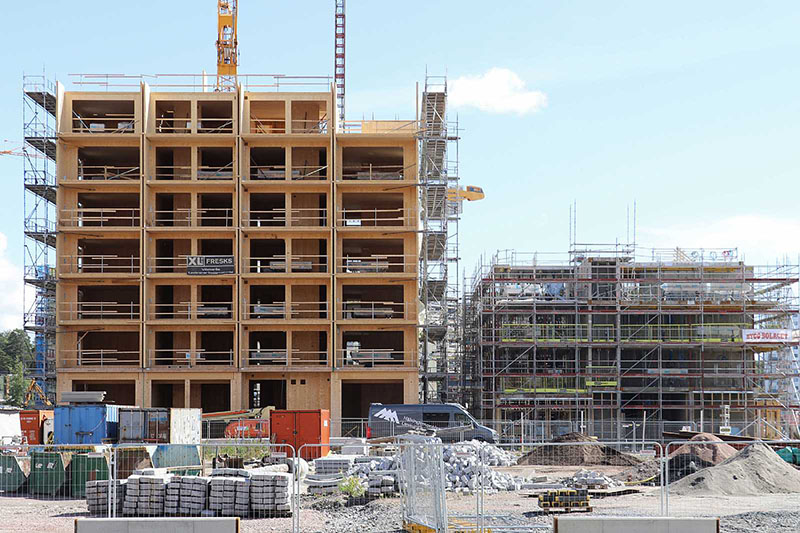
Kajstaden Tall Timber Building by C.F. Møller
On the manufactured products side, for example, research into materials and their limits of resistance has allowed Valcucine to revolutionise the kitchen industry with the first base unit system, called Invitrum, made entirely of glass except for an aluminium frame. A product designed to be circular, recyclable and easily disassembled (reused or recycled) at the end of the life cycle.
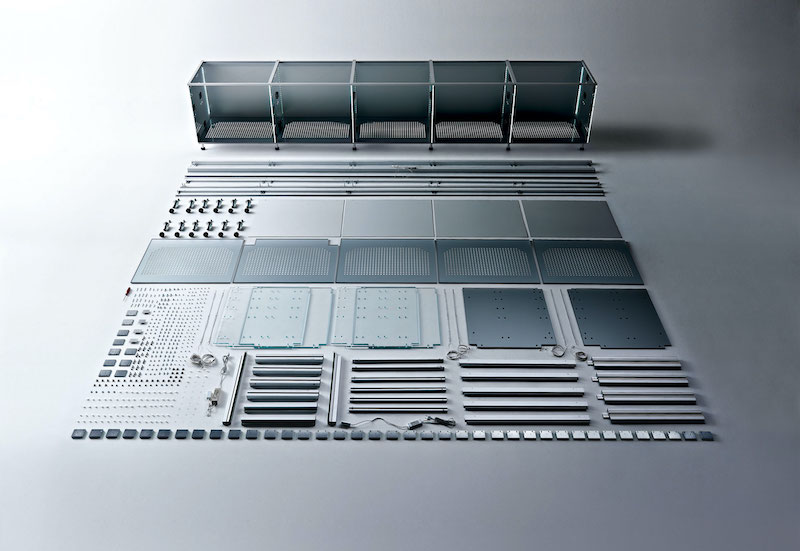
Norwegian architecture firm Snøhetta worked on a research project related to plastic aiming to understand plastic as a material, its journey and footprint in the value chain, as well as its inherent qualities. They has developed a chair, called S-1500, with a body made from 100 % recycled plastic from the local fish farming industry in the North of Norway, and a subframe made from recycled steel.
The materials used in the production of the S-1500 chair is provided by local fish farming companies like Kvarøy Fiskeoppdrett and Nova Sea, that supply the manufacturing compnay with worn-out fish nets, ropes and pipes from their operations.
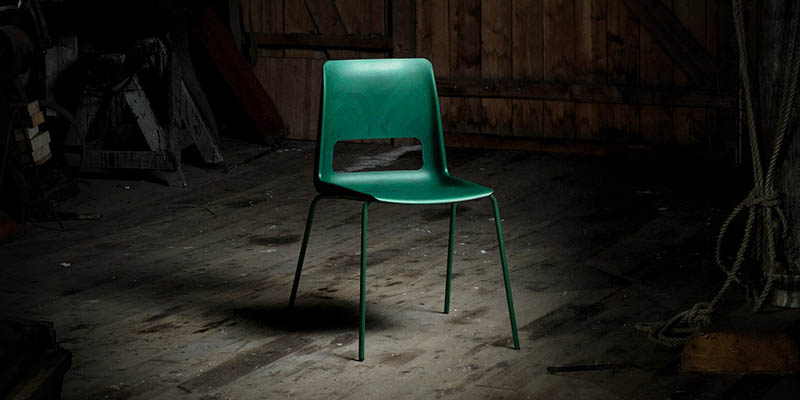
“But is not only a manufacturing thing. It is a paradigm shift!” says Anders Lendager “It is about the design, the CO2 emissions, the cost, the LCA… We have to rethink our own role within the building industry. There are many gaps on the wheel of circularity and what we have done is to focus on these gaps creating new business or solutions in the way to achieve circular economy in the build environment.
Every time you set a line in a drawing you made a CO2 impact and if you do not have consideration of what does it mean you are cheating the environment, your are cheating your business proposal, you are cheating as architect. We are all in this together.
As we have seen, tools, polices, encouragements, inspiring best practices, begin to spread.
The time to commit to change has really come.
Sources and inspirations:
Ellen MacArthur Foundation > Universal circular economy policy goals: enabling the transition to scale
ARUP > From principles to practices: realising the value of circular economy in real estate
European Commission > Circular Economy – Principles for Building Design
European Commission > European Platform on Life Cycle Assessment
Lendager Group > A changemaker's guide to the future


